Stories
Susan Holmes
1941-
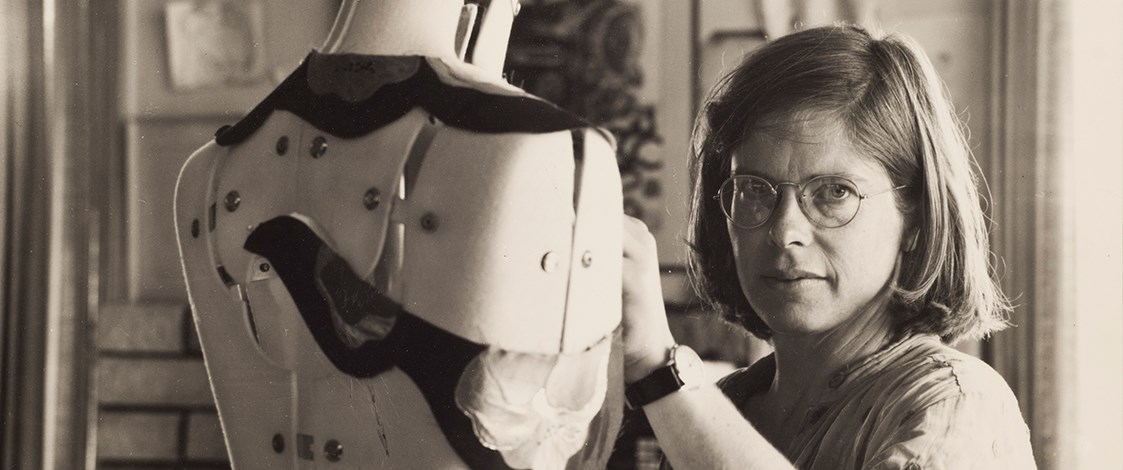
A serendipitous encounter with the humble potato, some silk and fabric print paste sparked something in Susan Holmes, and a lifelong career with fabric began.
Since 1971 Auckland fabric artist Susan Holmes has been captivating people with visual tales told through her modifications of both the surface and form of fabric. From selling hand dyed and printed garments at Auckland craft market Brown's Mill, through the fantasy of the Benson & Hedges Fashion Design Awards and into the World of WearableArt, Susan’s career spans craft, fashion and fabric art. Her earliest work of simple scarves and shirts with potato printed motifs, soon made way for more complex and refined printed garments, lusciously dyed silks, and later technically complex wearable art. As a resourceful and innovative creator, Susan developed and mastered a broad repertoire of techniques to treat and manipulate cloth. She immersed herself in the world of fabric craft; researching, exploring and experimenting; engaging with the material and with her customers; developing treatments like block printing, stencilling and spraying, ombré dip-dye, crinkle silk and shibori. Her work has defined and reflected the changing landscape of these fields in New Zealand for nearly half a century.
Listen to an interview with Susan Holmes, 1 June 2013.
Here as she was completing her degree in 1963 she met and married poet David Holmes. Together they went on an OE to England and during their overland trip home Susan discovered her love for the world of fabrics in the vividly coloured, richly woven, embroidered, dyed and printed textiles she saw en route. Arriving back in New Zealand at the start of the 1970s Susan’s marriage to David broke up while at the same a new interest was born. A chance encounter with a friend who wanted to learn screen-printing led Susan to the creation of a simple, potato-block printed, silk scarf and sparked a lifetime of fabric artistry.
In 1971 just six weeks after printing that first scarf Susan began to work full time selling hand printed and dyed garments. Initially she sold scarves and 'Indian shirts' (kurta) through small fashion boutiques like Trina J in Auckland’s city centre. Her creations proved popular and she began looking further afield for opportunities to expand her creative enterprise. A year later in 1972 she joined the popular craft cooperative The Mill (commonly known as Brown's Mill). "The Mill was in a stone building, with old wood, it was only open [on] Friday and Saturday. And it was full! It was so packed, it was like the most crowded market on Saturdays. It was absolutely thriving. The customer would come in a big roller door and it would be quite crowded and cavernous, lots of wood and pottery around, little winkling twinkling lights everywhere and absolutely gorgeous stuff and lots of interesting people that you could talk to ... all having a social time and selling. I would be there with a big bundle of dresses that I had made, anything from four to six dresses a week."
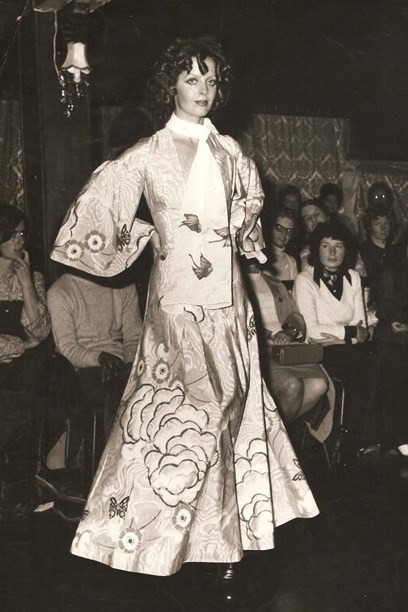
Susan used stencils to print this evening dress and silk scarf, pictured in a fashion parade at Brown's Mill. Image © Susan Holmes.
While still selling at The Mill, Susan made the decision to move herself and her young son Alex, born in 1974, to live in the Centrepoint community, a commune near Albany. Alex was five and the child-care support of the commune enabled her to continue working. The creative environment and support with garment production and with everyday household tasks allowed her to further develop her textile craft. She also started holding art therapy workshops leading to a significant involvement in teaching fabric-dyeing and wearable art in New Zealand and Australia, passing on her knowledge within the textile community.
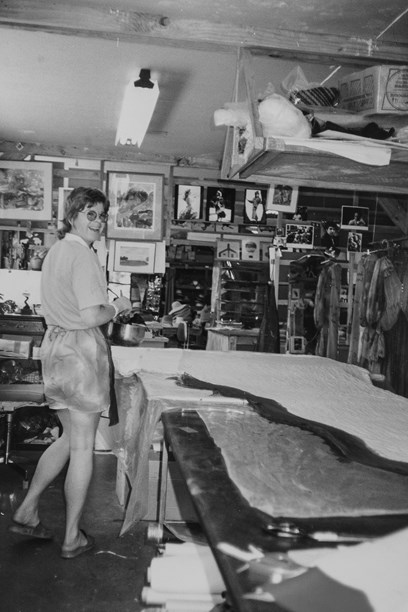
Susan's work area at Centrepoint, 1980s. Photo by Phil Fogle © Phil Fogle.
In 1981 Susan married photographer Phil Fogle and they had twins, Sam and Sally. Phil was working for Fashion Quarterly and the recently launched More magazine and his photos of her designs frequently appeared in fashion editorials. This symbiotic relationship gave coverage to Susan’s work and built Phil’s reputation.
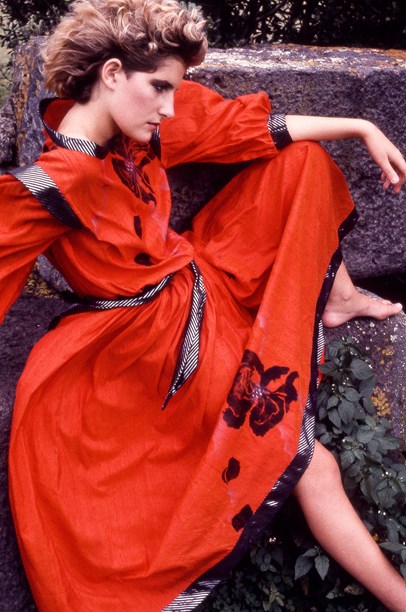
Many of Phil Fogle's photographs of Susan's designs were published in local fashion magazines during the 1980s. Image © Phil Fogle.
The 1970s and 1980s were the time when Susan’s garments were most connected to the fashion sphere. However, as noted by New Zealand curator Lucy Hammonds, they were 'on fashion’s fringes'. Her early work aligned clearly with a fashionable hippie aesthetic; voluminous empire line maxi dresses, fitted wrapped kimono styles and floaty, whimsical silhouettes all embellished with Susan’s signature prints. In the 1980s Susan picked up design features of the era like bat-wing sleeves and abstract prints.

Susan Holmes swing tag. Image © Susan Holmes.
By the time the 1990s arrived, with its plain pared back style and neutral colours, Susan had found a new niche for herself in the burgeoning field of wearable art.
Throughout her career Susan has been closely connected with fashion parades, competitions and awards shows. Initially she participated in fashion parades held at The Mill and connected strongly to the dramatic and performance aspect of her clothing being shared in this manner. She was a regular entrant in the Benson & Hedges Fashion Design Awards at which she was a finalist every year for 14 years between 1974 and 1988. Throughout the 1980s and 1990s Susan entered and had successes in a variety of other award shows including the Mohair Awards, Craft Dyers Awards and Wool Board Awards. Susan also began entering wearable art shows and competitions which were emerging in the 1980s, led particularly by Pamela Elliot of Compendium Gallery in Auckland, including The Great New Zealand Cloak Competition and Dress Art.
Today it is Susan’s connection to the World of WearableArt that is the most well-known part of her career and has led to her being described as "one of the leading exponents of wearable art in New Zealand". Since first entering the awards in 1988 she has participated more than forty times and gained more than a dozen awards.
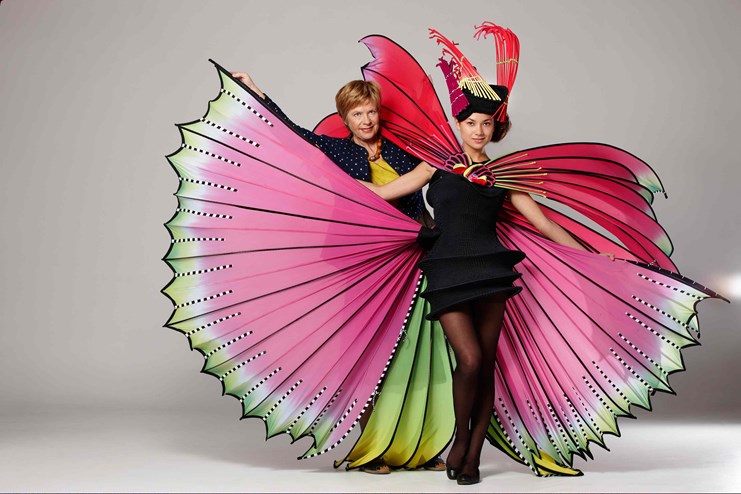
Susan's design, Firebird, was winner of the Untouched World 'WOW Factor' award in 2009. Image © Susan Holmes.
One of her best-known pieces, 'Dragon Fish', an elaborate fantasy costume constructed from split cane and brilliantly coloured silk, was the 1996 Supreme Winner.
Susan has exhibited regularly in solo and group shows and has also received several significant commissions across her career. For a period in the 1990s, Susan also worked in the costume department for the television series Xena: Warrior Princess and Hercules: The Legendary Journeys and on various other films.
Text by Cerys Dallaway Davidson. Banner photo of Susan Holmes in the early 1980s by Phil Fogle.
Last published November 2017.